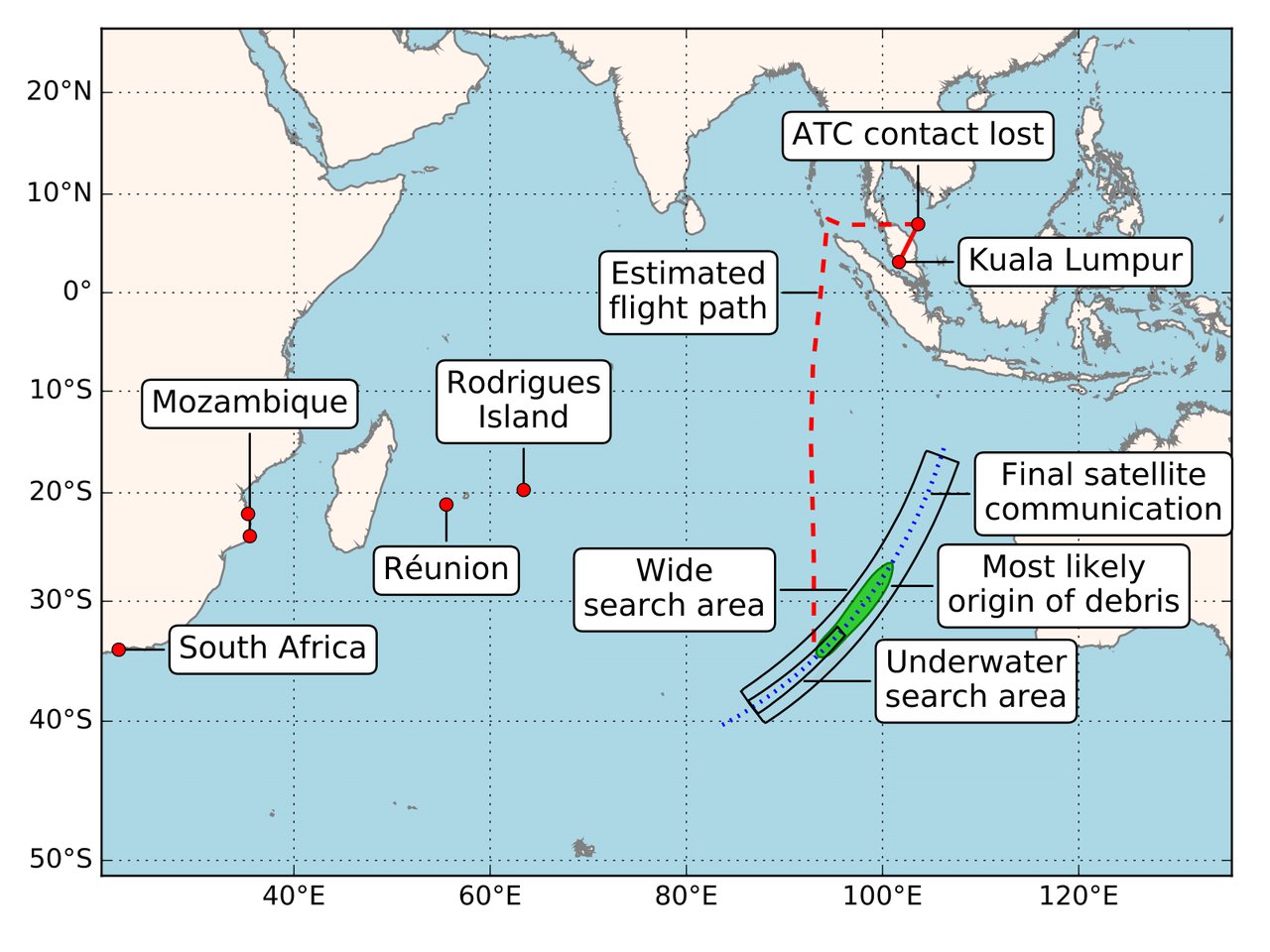
A team of researchers in Italy has used the location of confirmed debris from MH370 to determine where the airliner might have crashed, and where further debris could be found. The study is published in Natural Hazards and Earth System Sciences, an open access journal of the European Geosciences Union (EGU).
“Our result is the first to calculate the movement of the debris that best agrees with all five of the currently confirmed discoveries. This should make it the most accurate prediction,” says Eric Jansen, a researcher at the Euro-Mediterranean Center on Climate Change in Italy and lead-author of the study.
In March 2014, Malaysia Airlines Flight MH370 vanished with 239 passengers and crew on board. Extensive search efforts in the southern Indian Ocean, where the aircraft is thought to have crashed, have yet to locate the main wreckage, though debris have washed up on the African east coast and Indian-ocean islands.
The northern half of the area where authorities are currently searching for the plane, off the coast of Australia, overlaps with the area the new simulation indicates as the most likely origin of the debris found so far. “However, our simulation shows that the debris could also have originated up to around 500 km further to the north,” says Jansen. “If nothing is found in the current search area, it may be worth extending the search in this direction.”
To find out how MH370 debris drifted since the crash, the researchers ran a computer model that used oceanographic data from the EU Copernicus Marine Environment Monitoring Service, including data of global surface currents and winds over the past two years. To improve their simulation, they used the locations of the five confirmed debris found to date: two in Mozambique and one each in Réunion, South Africa and Rodrigues Island (Mauritius).
They started their computer simulation by placing a large number of virtual particles in the ocean, and then examined where they would go based on the ocean currents and winds after the crash. Since the exact crash location and how much of an effect wind has on the debris are unknown, researchers simulate different scenarios. From this, they could construct a so-called superensemble: a combination of simulations that best describes the debris found so far.
“Imagine that you want to know what the weather is going to be tomorrow, but you have several websites that give contradictory information. Which one do you trust? You check what weather they predicted for today and you put more faith in the websites that were correct and less in those that were wrong,” Jansen explains. “This is more or less what we do for MH370: we perform many simulations that are all plausible given the information that we know about the flight. When we combine the results of all these simulations, we give more importance to those that predicted the debris that was found correctly.”
“If new debris is discovered, we can update the result in a matter of minutes,” says Jansen. In the first stage of the simulation, the computer model calculates the various ways in which debris could have drifted, which takes some time on the Supercomputer. But the locations of the discovered debris are only used in the final stage, when combining the possible drift paths to find the most likely ones. Once the first stage of the computer model is run, it is quick and easy to incorporate new debris data.
The results indicate that the most probable locations to discover additional washed up debris are Tanzania and Mozambique, as well as the islands of Madagascar, Réunion, Mauritius and the Comoros. The main wreckage is likely to be in the wide search area between 28°S and 35°S (see Figure 1). This overlaps with the current underwater search area between 32°S and 35°S, but indicates the airliner could also be further north than where authorities are currently searching.

Figure 1: MH370 debris location and most likely origin compared to current underwater search area (Credit: Jansen et al., Nat. Hazards Earth Syst. Sci (2016))
“The disappearance of flight MH370 is probably one of the most bizarre events in modern history. It is important to understand what happened, not only for all the people directly involved, but also for the safety of aviation in general. We hope that we can contribute to this, even if our study is just a small piece of a very complicated puzzle.”
Citation: Jansen, E., Coppini G., and Pinardi, N.: Drift simulation of MH370 debris using superensemble techniques, Nat. Hazards Earth Syst. Sci., 16, 1623–1628, doi:10.5194/nhess-16-1623-2016, 2016.
The team is composed of Eric Jansen (Euro-Mediterranean Center on Climate Change [CMCC], Lecce, Italy), Giovanni Coppini (CMCC) and Nadia Pinardi (Department of Physics and Astronomy, Alma Mater Studiorum University of Bologna, Italy and CMCC).
Links
- Scientific paper: http://www.nat-hazards-earth-syst-sci.net/16/1623/2016/
- Journal – Natural Hazards and Earth System Sciences: http://www.natural-hazards-and-earth-system-sciences.net
- Source of the news: http://www.egu.eu/news/251/new-study-reveals-where-mh370-debris-more-likely-to-be-found/


